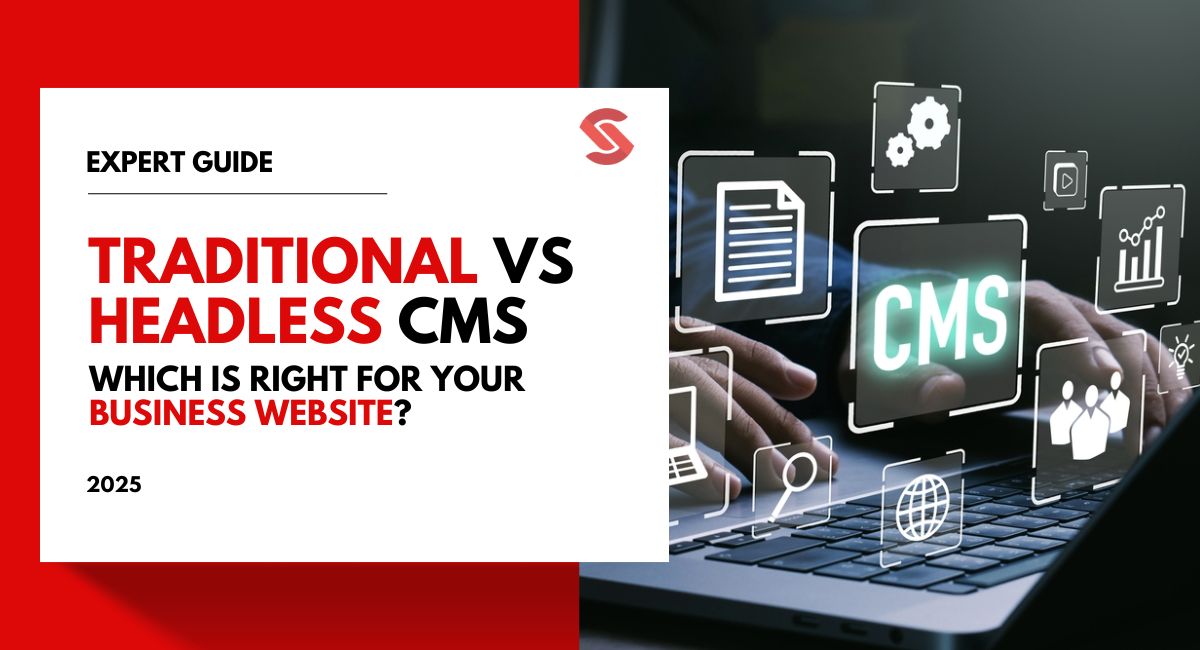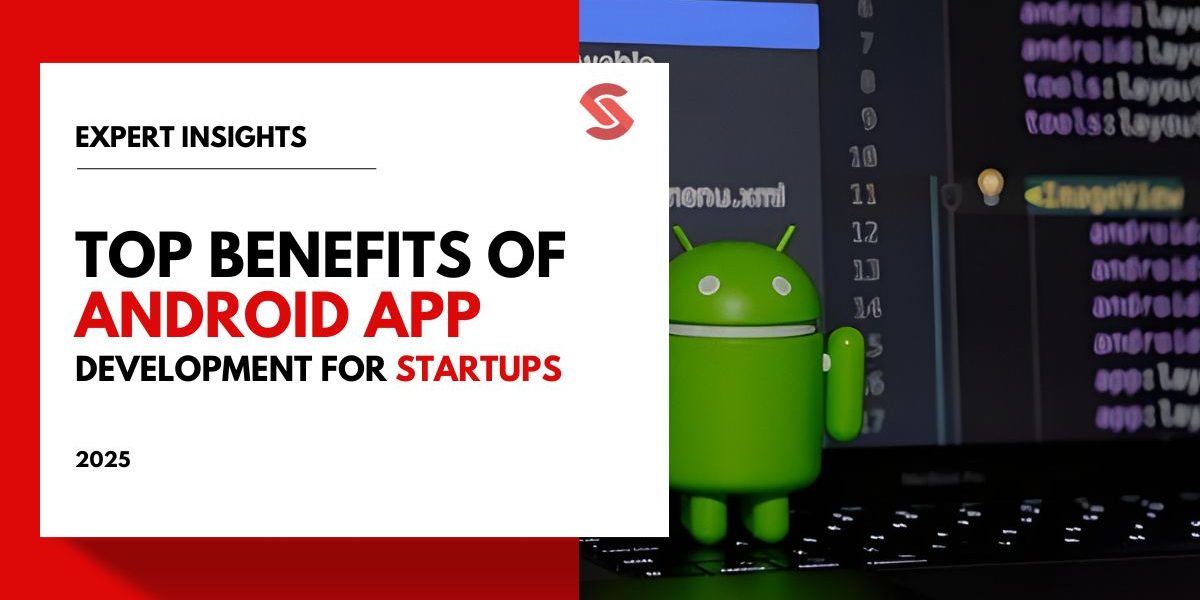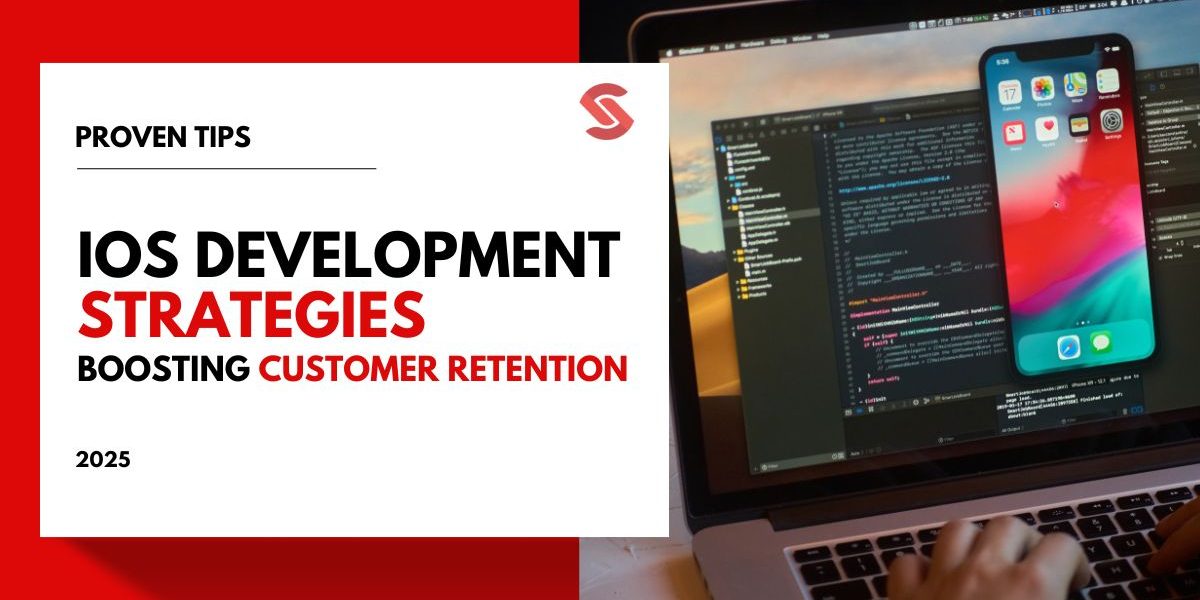Building your website is like you’re cooking a killer recipe, some chefs want a complete kitchen with all the gadgets, while others prefer a bare-bones setup with just the essentials. Content management systems (CMS) in this world work just like that.
Market experts predict the headless CMS software market will skyrocket from $751.6 Million in 2022 to $5,528.5 Million by 2032, growing at an impressive 22.1% annually. Choosing between headless and traditional CMS can feel like picking the right tool for a complex job. Some platforms offer you the whole package, while others let you customize your approach piece by piece.
Your website is more than just a digital storefront, it’s your brand’s first handshake with potential customers. Want to know which CMS might be your perfect match? We’ll break down the details and help you make a smart choice.
What is Traditional Content Management System?
Traditional CMS is a full-stack solution that combines both the front-end and back-end in a single system. This means you can manage the entire content experience, design, layout, and text directly from the CMS, making it ideal for standard websites and blogs.
With built-in templates and design controls, creating and managing your site’s look and feel is easy without needing advanced coding. While traditional CMSs are secure and user-friendly, they lack flexibility for publishing across multiple channels like apps or IoT.
What is Headless Content Management System?
Headless CMS offers more flexibility by separating the content back-end from the front-end, allowing you to publish across various channels. This API-driven approach allows developers to control how content appears on websites, mobile apps, or even IoT devices.
Because content is “headless,” it’s frontend-agnostic, meaning you’re not tied to any single platform. Headless CMSs are great for omnichannel publishing, enabling brands to engage users anywhere while offering scalability and customization suited to unique project needs.
List of Traditional CMS
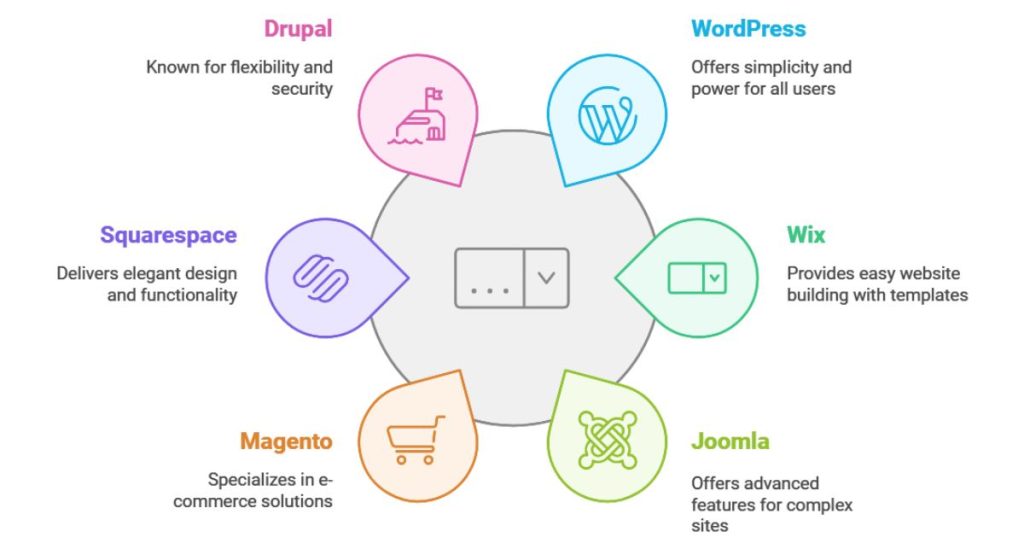
Traditional Content Management Systems (CMS) are essential tools for building and managing large, complex websites that need lots of control and customization. They are like super-powered website builders they’re open-source, meaning anyone can access and modify their code.
What makes them special is how they let you organize content in smart ways, manage different user roles, and connect with other digital tools. Plus, they have strong communities of developers who keep improving them.
1. WordPress
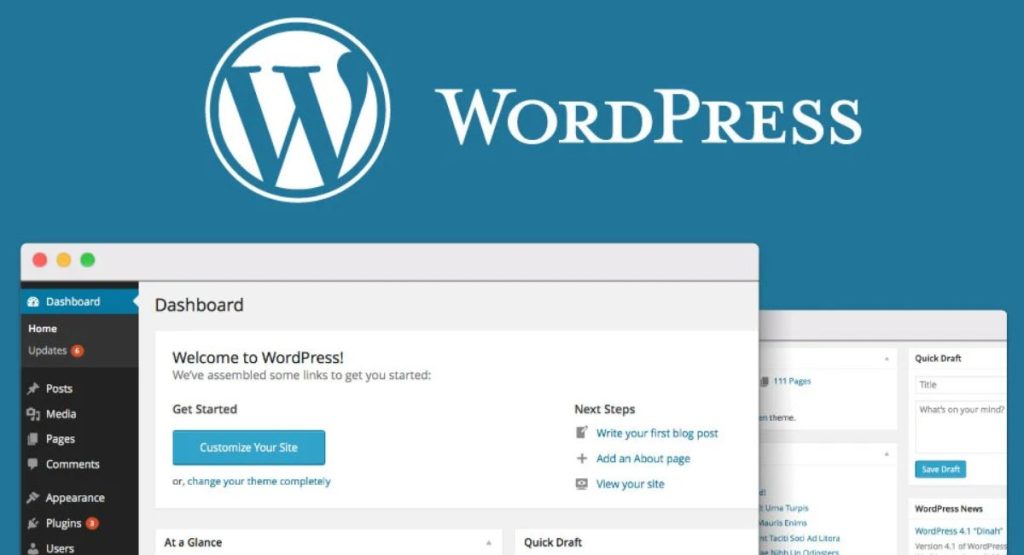
As the world’s most popular content management system, WordPress offers an incredible blend of simplicity and power. Its user-friendly Gutenberg editor makes content creation a breeze. At the same time, thousands of plugins, themes, and expert wordPress development services let you customize your site exactly how you want it.
Perfect for blogs, business websites, or online stores, WordPress has built-in SEO features and enjoys support from a massive community of developers and users. WordPress adapts to your needs, whether you’re a beginner or a pro.
2. Wix
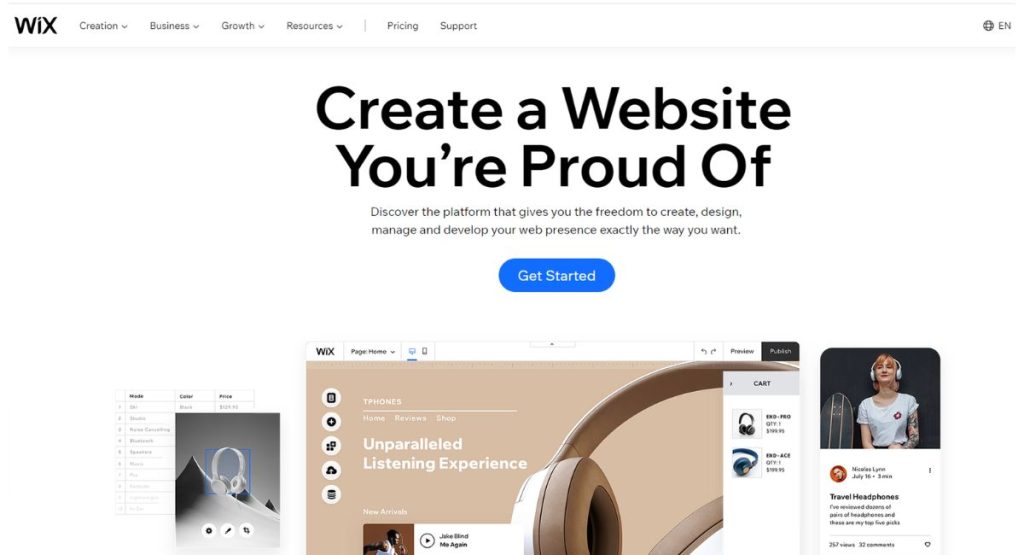
Wix is a hassle-free website builder that handles all the technical stuff for you. Its drag-and-drop editor and stunning templates make it super easy to create professional-looking websites without touching any code.
While you might not get the deep customization of open-source platforms, Wix delivers everything small businesses need from built-in SEO tools to mobile-responsive designs, all hosted on their reliable platform.
3. Joomla
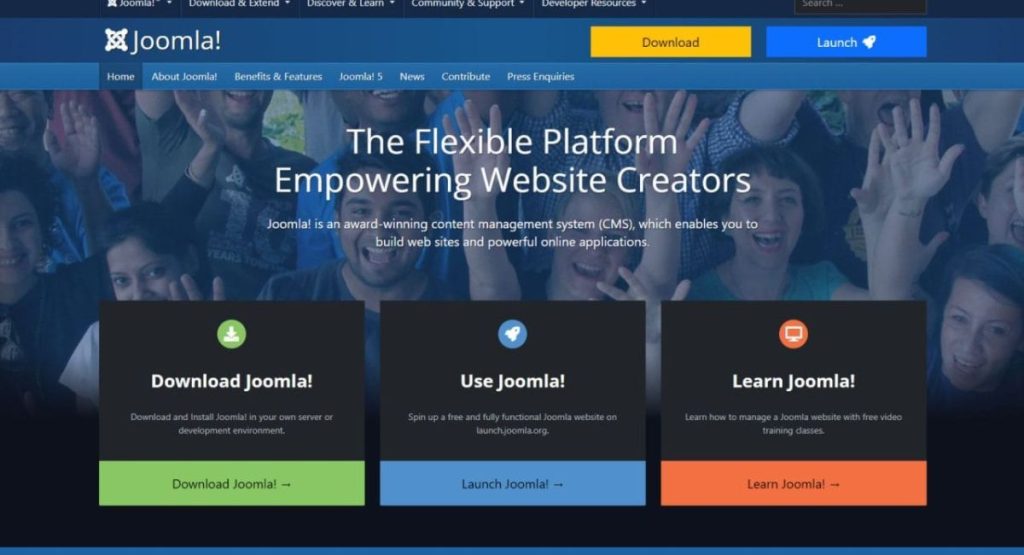
Joomla packs powerful features for those who need more control over their website structure. This open-source CMS shines with its advanced user management and built-in multi-language support, making it perfect for complex websites.
While it might take more time to learn than WordPress, Joomla rewards you with incredible flexibility through its extensive collection of extensions and strong security features. It’s particularly great for larger organizations needing detailed content organization.
4. Magento
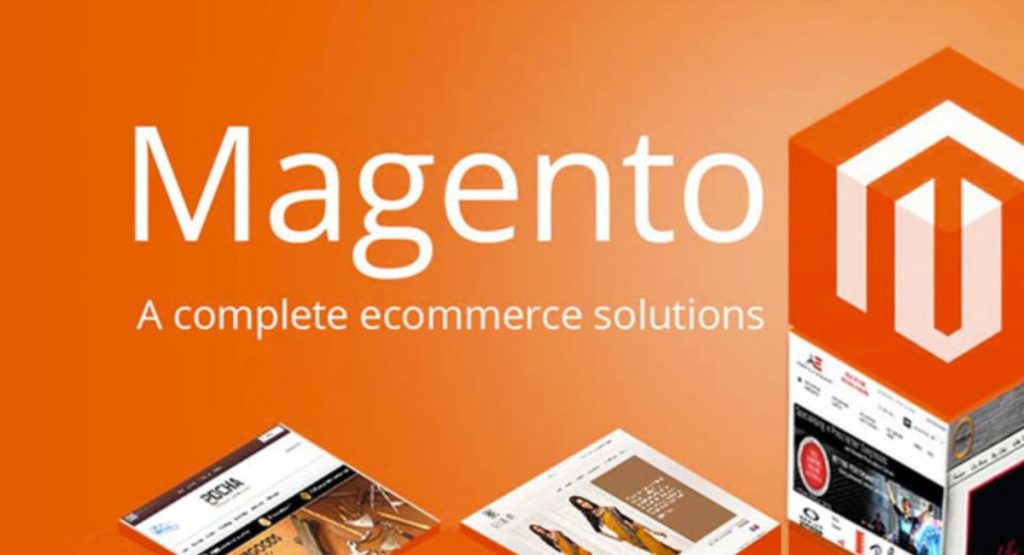
As a trusted e-commerce platform, Magento brings advanced capabilities for online retailers and digital storefronts. The platform offers both free and premium versions, making it accessible for various business sizes. It shines at managing extensive product collections, streamlining inventory tracking, and processing payments smoothly. Store owners appreciate its built-in SEO tools and the flexibility to run multiple stores in different languages, while magento development services provide developers with extensive customization options to enhance functionality.
5. Squarespace
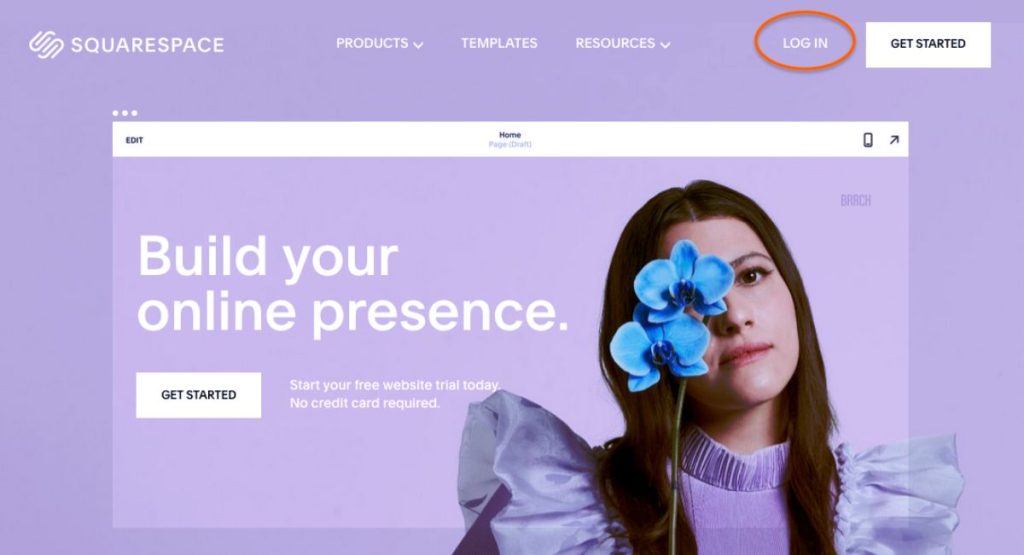
Built for simplicity and elegance, Squarespace delivers a complete website solution that combines hosting, design, and functionality. The platform stands out with its polished, mobile-friendly templates and intuitive drag-and-drop editor. Users can quickly launch blogs, online stores, and professional websites without technical knowledge. While customization options are more limited than some competitors, Squarespace excels in providing a streamlined, visually appealing experience with integrated marketing tools.
6. Drupal
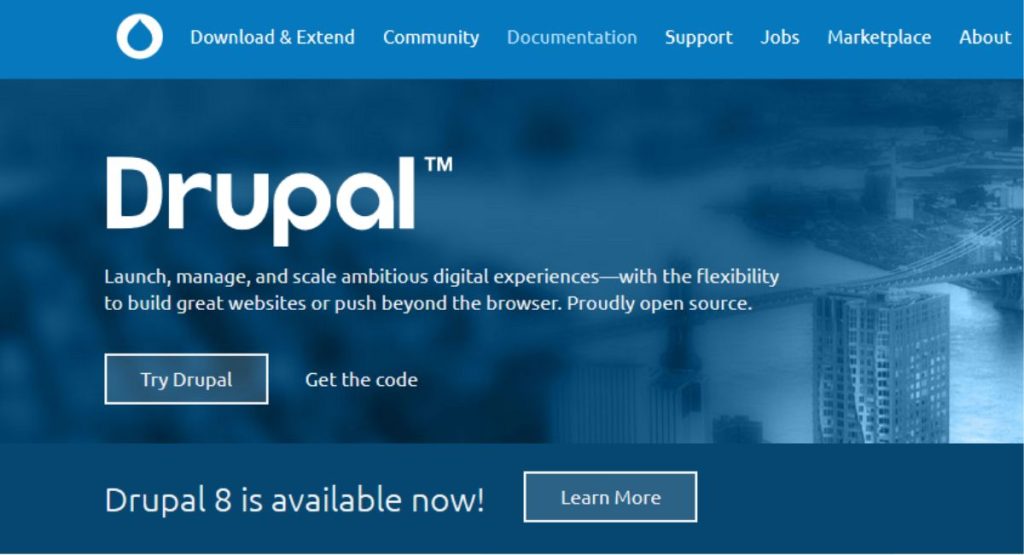
Known for its exceptional flexibility, Drupal empowers organizations to build sophisticated websites and digital experiences. This open-source platform excels at organizing complex content structures and managing detailed user permissions. Developers appreciate its robust API capabilities and extensive module system, while businesses benefit from its enterprise-grade security features. The active community continuously contributes improvements, making it ideal for large-scale projects requiring precise control.
Lists of Headless CMS Platforms
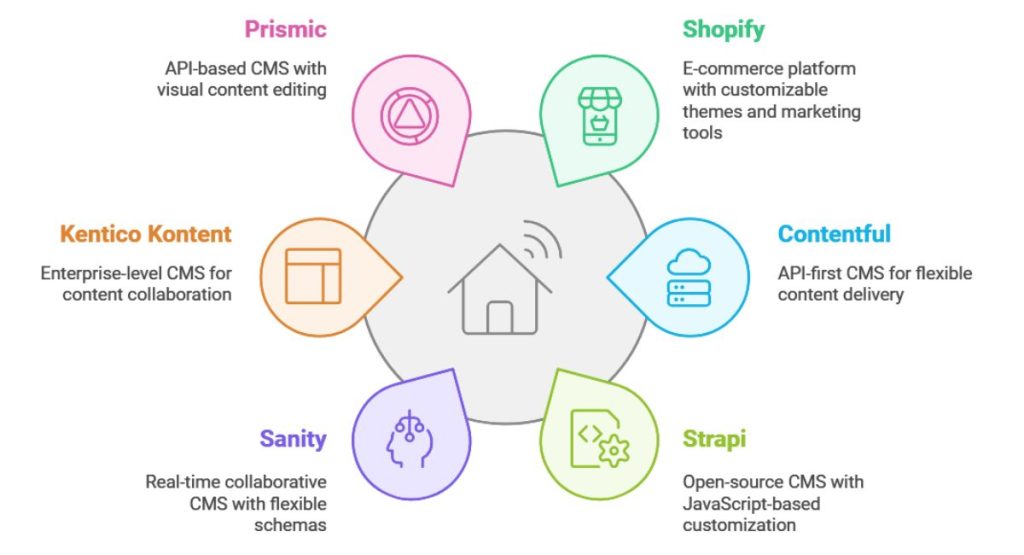
Headless CMS platforms offer a modern approach to content management and distribution. These systems prioritize delivering content through APIs, making it simple to share your information across different platforms and devices.
What’s fantastic about headless CMSs is the freedom they give developers to customize and the flexible way they handle content modeling. They also provide robust collaboration and localization tools for content teams. Whether you’re working on a website, mobile app, or connected device, these API-driven platforms can support your evolving content strategy with agility and ease.
1. Shopify
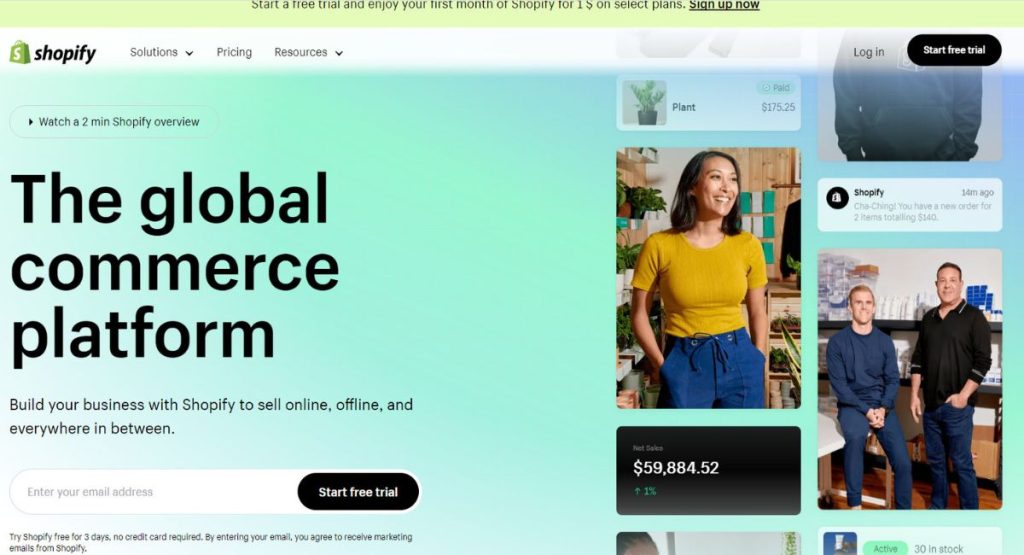
Shopify is an e-commerce-focused CMS that makes it easy for businesses to set up and manage their online stores. It provides powerful tools for managing products, processing payments, and tracking inventory. What’s great about Shopify is its wide range of customizable storefront themes and the availability of shopify development services to tailor functionality to specific business needs. Secure payment options and built-in marketing features like discount codes are also included. Plus, there’s a huge app marketplace to add even more functionality.
2. Contentful
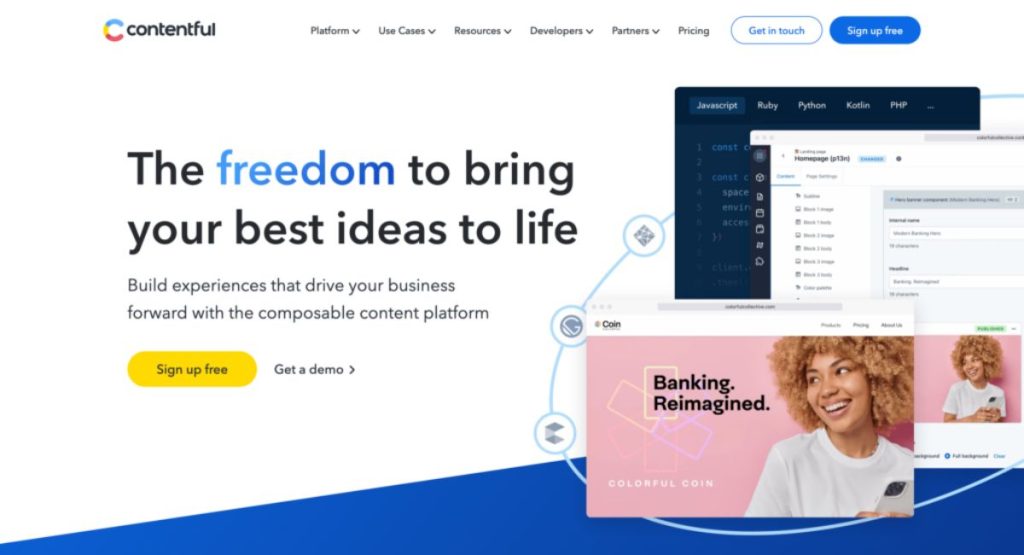
Contentful is a headless CMS, which means it’s all about delivering content through APIs rather than traditional web pages. This “API-first” approach makes it super flexible for creating content-rich experiences across different devices and platforms. Developers love how they can build custom content models and workflows, while also taking advantage of features like content scheduling, versioning, and integrations with other tools.
3. Strapi
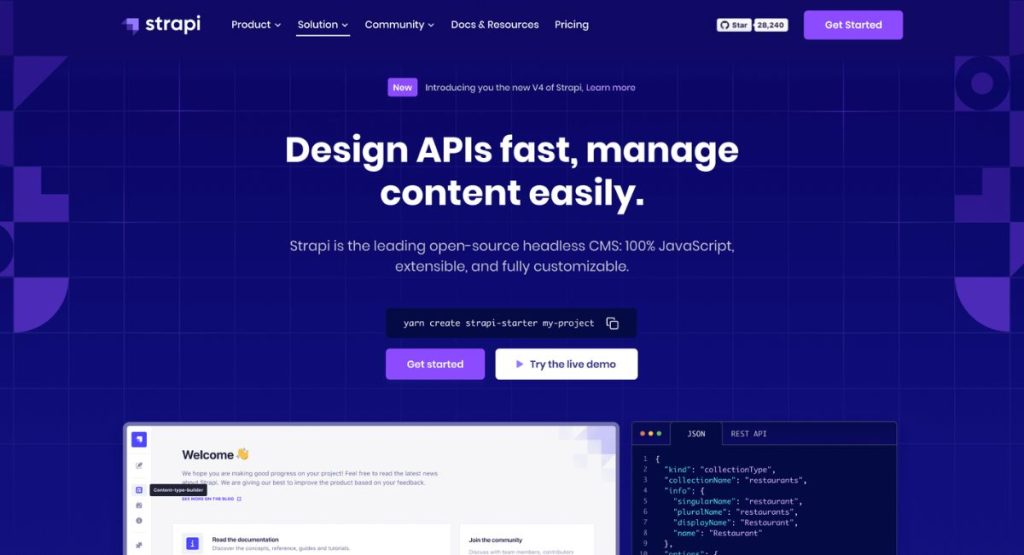
Strapi is an open-source, headless CMS with a strong focus on developers. It’s built using JavaScript and gives you total control over your content architecture, permissions, and API. What’s cool is how easily you can customize Strapi to fit your specific needs, whether you’re building a complex web application or a simple content-driven website. And with features like multilingual support and front-end framework integration, it’s a great choice for ambitious digital projects.
4. Sanity
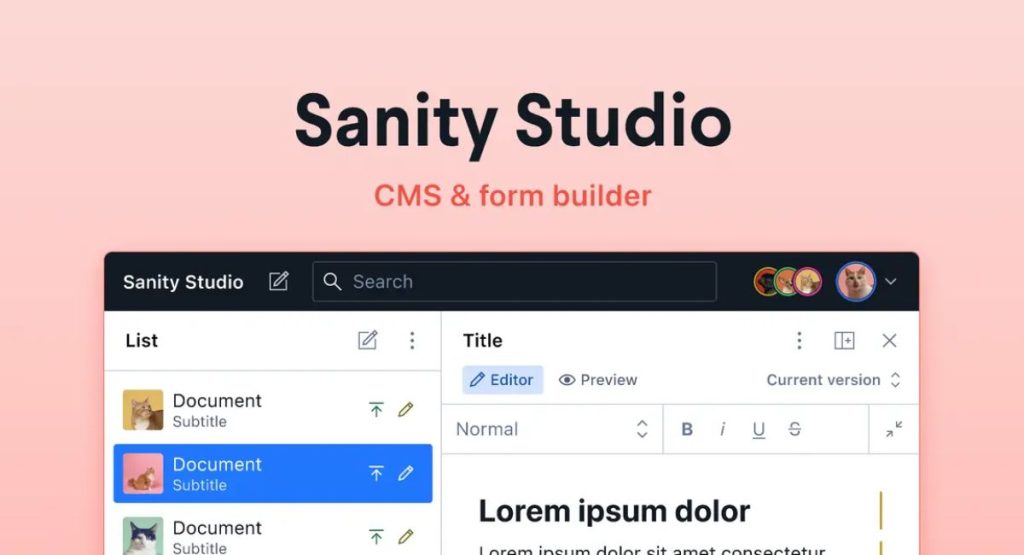
Sanity is a powerful, real-time collaborative CMS that puts developers first. It stores content in a structured way, making it easy to manage and distribute across various platforms. What’s great about Sanity is its flexible content schema, which lets you customize the data model to fit your specific needs. Developers also love the integration with Jamstack frameworks and the ability to query content using the intuitive GROQ language.
5. Kentico Kontent
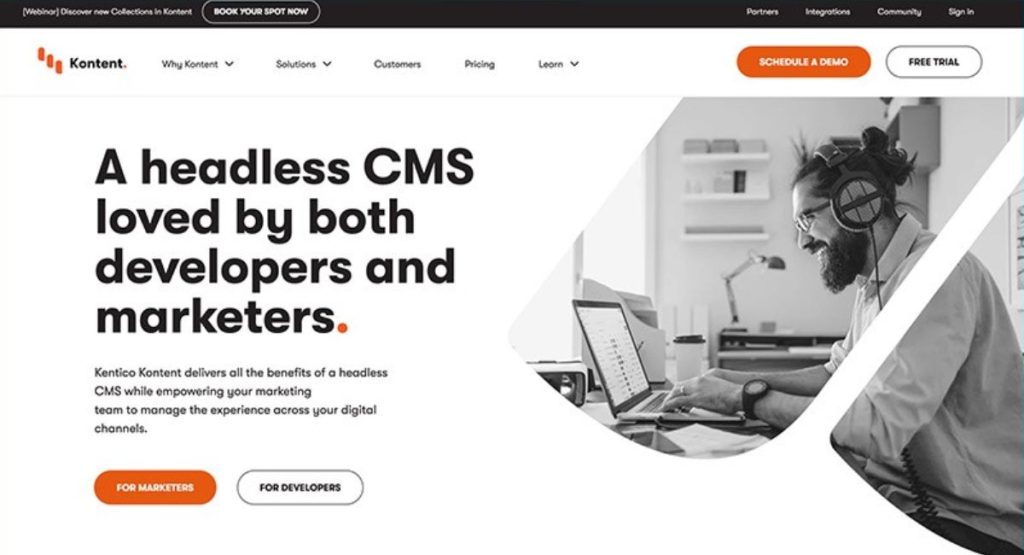
Kentico Kontent is an enterprise-level headless CMS that shines when it comes to content collaboration and multichannel management. It provides advanced tools for teams to work together on content, including localization and user permissions. What’s impressive is how Kontent can serve as a full-fledged digital experience platform, with features for analytics, marketing, and cloud-based scalability to support even the largest organizations.
6. Prismic

Prismic is an API-based, headless CMS that makes it easy to schedule, version, and visually edit your content. It’s designed with marketers in mind, offering features like custom content types, dynamic previews, and automation tools. What’s cool about Prismic is its document-based structure, which allows non-technical users to intuitively manage and update content, while developers can easily integrate it with modern web frameworks.
Key Differences Between Headless and Traditional CMS
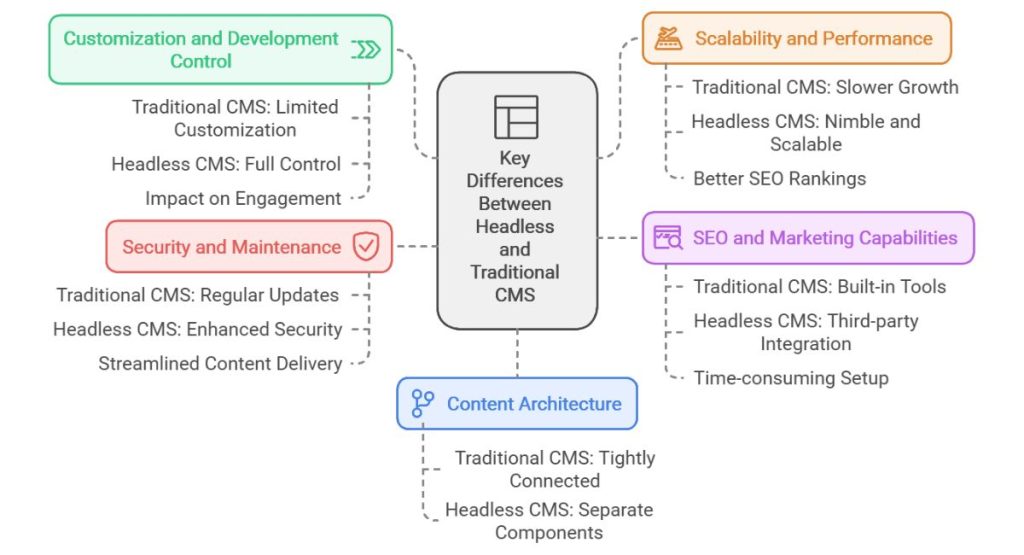
Traditional and headless CMS take fundamentally different approaches to managing and delivering content. Traditional CMS bundles everything together, content management, templates, and how your site looks, making it ideal for straightforward websites.
Headless CMS splits these parts up, keeping content separate from how it’s displayed, which lets businesses share content across websites, apps, and other digital platforms.
While traditional CMS offers simplicity and quick setup, headless CMS provides more freedom in how and where your content appears. This key difference affects everything from website design to how your business connects with customers across different platforms.
1. Content Architecture and Flexibility
Content architecture is where headless and traditional CMS take different paths in managing your website’s building blocks. Traditional CMS keeps everything tightly connected, your content and how it looks are packaged together, like a pre-furnished house. On the other hand, headless CMS splits these apart, treating your content like versatile building blocks that can be used anywhere.
As Sarah Winters, a Content Design Expert says “Headless CMS is like having a universal remote for your content; it works everywhere, while traditional CMS is more like a device-specific remote.” This flexibility means your content can easily flow to websites, apps, or any digital platform you choose.
2. Customization and Development Control
Customization and control over development can make a big difference in content management. With a traditional CMS, you get out-of-the-box solutions that simplify setup but can limit customization.
A headless CMS, however, gives developers full control with API-based content and flexible design options, making it easier to craft unique, modular experiences across platforms. According to the Adobe Digital Trends Report, customized user experiences can boost engagement by up to 30%, highlighting why developer control is crucial for impactful content delivery.
3. Scalability and Performance
When it comes to handling growth and speed, headless and traditional CMS show their true colors in different ways. Traditional CMS might slow down as your site grows because it combines everything, content, design, and functionality into one package. Headless CMS, however, stays nimble by keeping these elements separate, making it easier to scale and maintain fast performance.
Key benefits of better scalability and performance:
- Faster page load times, keeping visitors happy and engaged
- Smooth handling of traffic spikes during busy periods
- Flexibility to add new features without slowing down
- Better SEO rankings due to improved site speed
- Enhanced user experience across all devices
- Reduced server costs as you grow
4. SEO and Marketing Capabilities
Traditional CMS platforms come with ready-to-use SEO and marketing tools right out of the box, making it easier for content teams to optimize their websites without hassle. You can find built-in features like meta tag editors, XML sitemaps, and keyword optimization tools at your fingertips.
Headless CMS requires more setup; You will need to integrate third-party tools for these functions. This setup process can be time-consuming, as shown by WP Engine’s 2023 research shows that teams spent almost twice as long getting their SEO tools running compared to traditional CMS users.
But don’t let that discourage you because the extra effort opens up possibilities to choose specialized tools that perfectly match your needs, from advanced analytics to sophisticated marketing automation solutions.
5. Security and Maintenance
Headless CMS platforms offer enhanced security due to their API-based structure, which separates the content management backend from the frontend display. This design minimizes exposure, making it harder for hackers to target.
Traditional CMSs, however, need regular updates to protect against vulnerabilities, requiring careful maintenance to keep them secure. With headless CMS, you get streamlined, secure content delivery, while traditional systems demand more time spent on patches and updates to ensure a safe user experience.
Pros and Cons of Headless CMS
A headless CMS offers great flexibility and scalability, allowing content to be delivered seamlessly across multiple platforms. However, it often requires more complex setups, higher development costs, and careful API management.
Here’s a breakdown of the pros and cons:
| Aspect | Pros | Cons |
|---|---|---|
| Multi-platform Delivery | Delivers content to multiple platforms (web, mobile, IoT) easily | More complex setup compared to traditional CMS |
| Flexibility & Scalability | Highly flexible and scalable, ideal for growing businesses | Higher initial development costs, especially for smaller teams |
| Customization | Allows advanced customization to meet specific branding needs | Requires ongoing API management, adding maintenance complexity |
| Performance | Enables fast performance by separating content from presentation | Increased reliance on developers, which may be challenging for non-technical users |
| Future-Proofing | Adapts well to new technologies and frameworks | Limited built-in features, often needing third-party integrations |
Pros and Cons of Traditional CMS
A traditional CMS is easy to set up and comes with built-in features that simplify content management, making it ideal for smaller websites or non-technical users. However, it lacks the flexibility and scalability needed for multi-platform content.
Here’s a quick look at the pros and cons:
| Aspect | Pros | Cons |
|---|---|---|
| Ease of Use | User-friendly with visual editors, suitable for non-technical users | Less flexibility for custom designs, as front-end and back-end are tightly connected |
| Built-in Features | Includes themes and plugins, making setup easier | May slow down as content and traffic increase |
| Content Management | Combines content management and presentation in one platform | Limited multi-platform support, primarily web-focused |
| Setup & Maintenance | Quick to set up and manage, great for smaller websites | Security issues may arise from updates or plugins |
| Cost | Lower setup costs, making it ideal for small to medium projects | Harder to keep up with new technology, often needs major overhauls |
Which CMS is Right for Your Business? Key Considerations
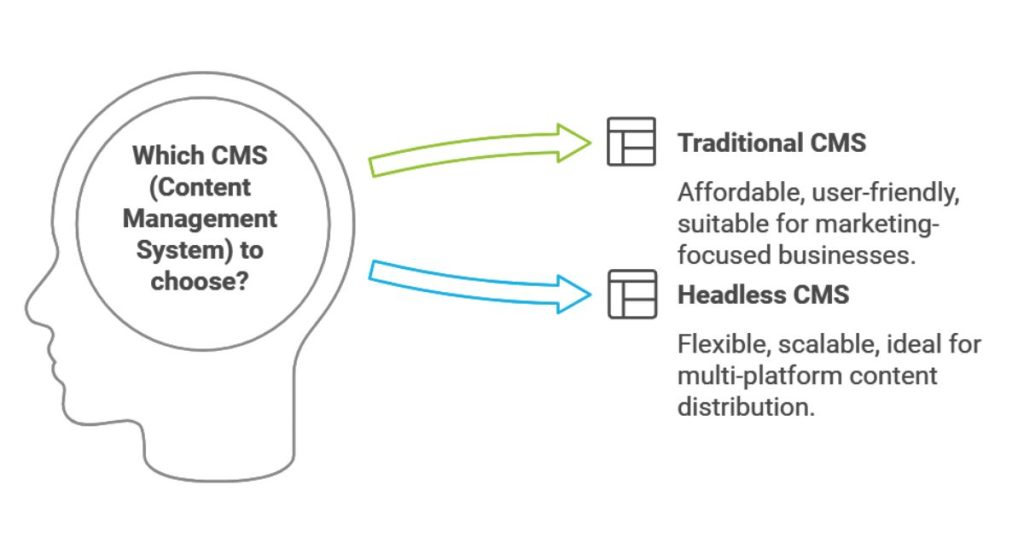
Picking the perfect CMS for your business is like finding the key to unlock your content management opportunities. You’ll want to carefully consider factors like your content needs, team’s technical expertise, budget constraints, and design preferences.
User-friendly CMSs shine at simplicity, while developer-focused ones offer more customization power. And don’t forget to think long-term, how will your content and distribution channels change? Choosing the right CMS will ease your workload and scale alongside your growing business.
1. Business Goals and Content Strategy
When selecting a CMS, it’s crucial to align your choice with your business goals and content strategy. If your focus is on marketing and growing your online presence, a traditional CMS with built-in SEO and campaign tools may be the way to go.
Conversely, if you need to distribute content across multiple platforms and channels, a headless CMS offers the flexibility to easily publish to websites, mobile apps, IoT devices, and more.
If your goal is to boost marketing, a traditional CMS may offer more built-in tools for quick publishing and SEO. In fact, 68% of marketers say a flexible CMS significantly improves content reach and engagement. Understanding your specific content-centric or channel-specific needs will guide you toward the right CMS solution.
2. Budget and Resource Availability
When choosing a CMS, budget plays a big role in deciding between headless and traditional options. Traditional CMSs tend to be more affordable upfront, with lower development costs and simpler setups. But keep in mind, that they may have limitations on customization and integration.
Headless CMSs often require a higher initial investment, as you’ll need to build out the front-end content delivery layer. However, this approach offers greater flexibility and scalability in the long run. Carefully weigh your budget, resources, and long-term business needs to find the CMS that fits your financial constraints while still meeting your requirements.
3. Technical Expertise and Development Needs
The level of technical expertise needed can be a major factor when choosing a CMS. A headless CMS is typically developer-friendly, offering flexibility but requiring strong technical skills, especially with API integrations.
On the other hand, a traditional CMS is more accessible and often designed with non-developers in mind, making it easier to manage content without coding knowledge. As CMS expert Deane Barker says, “A headless CMS empowers developers but challenges marketers; a traditional CMS empowers marketers but limits developers.”
4. Future Growth and Scalability
Choosing a CMS with future growth in mind can save a lot of hassle down the line. A headless CMS is ideal for businesses expecting rapid growth, as it’s highly scalable and can handle complex, multi-platform expansions. Meanwhile, a traditional CMS may suit smaller projects where scalability isn’t a top priority.
But why future scalability matters:
- Handles traffic spikes: Ensures smooth performance during high demand.
- Supports content expansion: Easily adds new channels without major rework.
- Adapts to tech changes: Stays compatible with evolving digital tools and platforms.
Conclusion
By the end of this blog, we hope you have understood the importance of selecting a CMS that aligns with your business goals, content needs, and growth plans. Traditional CMS platforms provide robust options for content-rich websites, while headless CMS solutions enable flexible, omnichannel content delivery through APIs.
Ultimately, the best choice depends on your specific requirements, whether for advanced content organization, multi-channel reach, or a blend of both. Investing in a CMS aligned with your technology strategy can empower content management, enhance user experience, and fuel business growth.
Why Softnix is the Best Choice for Headless or Traditional CMS
When it comes to choosing a development company for headless or traditional CMS, Softnix stands out as a trusted partner. With deep expertise in both CMS services, Softnix offers tailored guidance to help businesses select the best fit for their goals and resources.
Our expert team of web developers not only excels in development but also provides hands-on support to ensure project success. For reliable CMS solutions that prioritize client needs, Softnix CMS services are a smart, dependable choice.
FAQs about Headless CMS vs Traditional CMS
What is the difference between headless CMS and traditional CMS?
A headless CMS decouples content storage and delivery, allowing it to distribute content across multiple channels via APIs. A traditional CMS combines content and presentation, making it simpler for direct website management but less flexible for omnichannel delivery.
How do I know if a headless CMS is right for my business?
A headless CMS is ideal if you need multi-channel content delivery (e.g., website, mobile app, IoT). It works best for businesses that prioritize flexibility and scalability and have the technical resources to support API-driven platforms.
Is a headless CMS more secure than a traditional CMS?
Generally, headless CMS platforms offer better security as the content layer is separated from the presentation layer, reducing the risk of front-end vulnerabilities. However, security ultimately depends on the specific setup and adherence to best practices.
Which CMS is better for SEO: headless or traditional?
Both CMS types can be SEO-friendly with proper configuration. Traditional CMS often has built-in SEO tools, while a headless CMS requires custom integration but can be optimized to support complex SEO needs across multiple channels.
How much does it cost to implement a headless CMS?
Costs vary widely, from affordable, open-source options to high-end enterprise solutions. Budget for initial setup, API integration, and developer resources, as headless CMS often requires more customization than traditional options.
Can a traditional CMS be converted to a headless CMS?
Yes, it’s possible to transform a traditional CMS into a headless setup by decoupling the front end and back end. This process requires development work to create API connections for flexible content delivery.
What are the advantages of a headless CMS?
Key advantages include flexibility for multi-channel content delivery, scalability, better security, and adaptability with modern front-end frameworks. A headless CMS supports rapid changes and ensures content can be reused across platforms.
Is a headless CMS better for e-commerce websites?
Yes, headless CMS works well for e-commerce, as it allows personalized, API-driven experiences across platforms and devices, creating a seamless customer experience. However, it requires development resources to manage.
What are the challenges of using a headless CMS?
Headless CMS platforms can be complex to set up and manage, often requiring skilled developers. Content preview, SEO configuration, and initial implementation are more challenging compared to traditional CMS options.
Do I need a developer to manage a headless CMS?
Yes, a developer is generally required to set up and maintain a headless CMS, as it relies on API connections and custom front-end development. Ongoing support is often necessary for updates and optimizations.
Which is easier to use: headless CMS or traditional CMS?
Traditional CMS platforms are usually easier to use, especially for non-technical users, as they offer built-in front-end capabilities. Headless CMS offers flexibility but typically requires technical knowledge to manage.
Can I use a headless CMS for a small business website?
Yes, but it’s only recommended if the small business needs multi-channel content or has a development budget. Traditional CMS may be simpler and more cost-effective for small websites with fewer content distribution needs.
How does a headless CMS work with front-end frameworks?
A headless CMS works seamlessly with modern front-end frameworks (e.g., React, Vue) by delivering content via APIs. This enables flexible content management and a customized user interface across various devices and platforms.
Which CMS is more future-proof: headless or traditional?
A headless CMS is more future-proof due to its flexibility with API-driven content distribution, adapting to new channels and technologies. It’s well-suited for evolving digital landscapes compared to a traditional, tightly coupled CMS.
What industries benefit most from a headless CMS?
Industries requiring multi-channel content, such as e-commerce, media, finance, and technology, benefit most from a headless CMS. These sectors often demand omnichannel reach, adaptability, and personalized user experiences across platforms.

